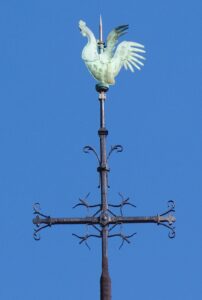Editor’s Note: Livestock Conservancy member and volunteer Carla Nordland of Montana wrote this blog post for History Month.
Any poultry keeper fortunate enough to keep a rooster can appreciate the nuance they bring to the flock. And we are not the first generation to celebrate the qualities of the cock or rooster; they are deeply entrenched into human history, folklore and religion, as is so beautifully demonstrated in the story of a rooster perched atop the spire at Paris’ Notre Dame Cathedral.
Cocks and roosters have a deeply entrenched symbolism to both the French and within Christianity. The rooster has long been considered a symbol of the French people due to a play on words. The Latin “gallus” refers both to one from Gaul (a western European region including modern day France) and the common rooster. In Christianity, the rooster is the “bird of light,” reminding believers of Christ and the Resurrection. It is central to the Biblical account of Peter denying Christ three times and served as a symbol of the power and authority of priests in the medieval church. The use of the rooster as a symbol atop weathervanes is equally ancient. In medieval Europe they were believed to have the power to detect changes in the weather and, following a ninth-century papal decree, were required on all church structures.

The original rooster atop one of the spires at Paris’ Notre Dame Cathedral
On April 15, 2019, France and the entire world watched as the ancient cathedral went up in flames, destroying much of the structure. A famed architectural detail of the cathedral, a rooster statue atop a 315-foot spire, was one of the casualties. This was more than just a structural loss. The statue held the following three sacred religious relics: a small piece believed to be from the Crown of Thorns; a relic of St. Denis; and a relic of St. Genevieve, the patron saint of Paris. The statue was placed atop the spire in an 1860 restoration of the cathedral. When the spire collapsed, it was assumed the statue and its sacred relics were lost as well.
The morning of April 16, 2019 brought a miraculous discovery. The statue was recovered from the wreckage, damaged, but with all three relics intact. Its symbolism deepened, becoming a physical reminder of hope amid loss, resilience, and recovery. The relics were also rescued and the statue is now on display at a Parisian museum.
The tale of Notre Dame’s rooster came full circle just a few months ago on December 16, 2023, when a new golden rooster statue was placed atop the rebuilt Notre Dame spire, again containing the sacred relics. Although the spire was perfectly modeled after the original design, the new rooster is golden and features flame-like wings resembling a phoenix rising from the ashes. The statue was blessed by Paris Archbishop Laurent Ulrich before rising to once more watch over Paris.
The rebuilt Notre Dame cathedral is slated to reopen in late 2024.
Image credit: Hilader, CC BY-SA 4.0 <https://creativecommons.org/licenses/by-sa/4.0>, via Wikimedia Commons



